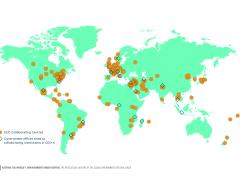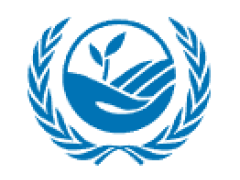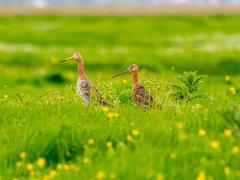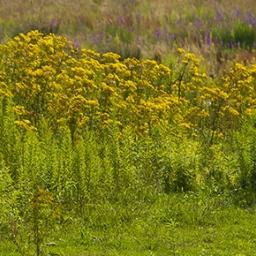New global biodiversity policy framework for 2030 central topic at upcoming meetings of the UN Convention on Biological Diversity
Most of the biodiversity targets that were agreed on by the United Nations for 2020 have not been achieved, with the exception of a few, such as the area of protected land. This was concluded by the Intergovernmental Science-Policy Platform on Biodiversity and Ecosystem Services (IPBES). Nature around the world is deteriorating, resulting in a decline in the natural foundation on which we build our livelihoods and quality of life. Furthermore, one million species are threatened by extinction. However, the IPBES report also has a positive message; alternative development paths are possible, in which nature is being protected, restored and used sustainably, while also contributing to achieving other Sustainable Development Goals, such as on climate change mitigation and adaptation, food security, healthy cities and clean water. This may only be achieved through transformative changes in economic, social, political and technological factors.
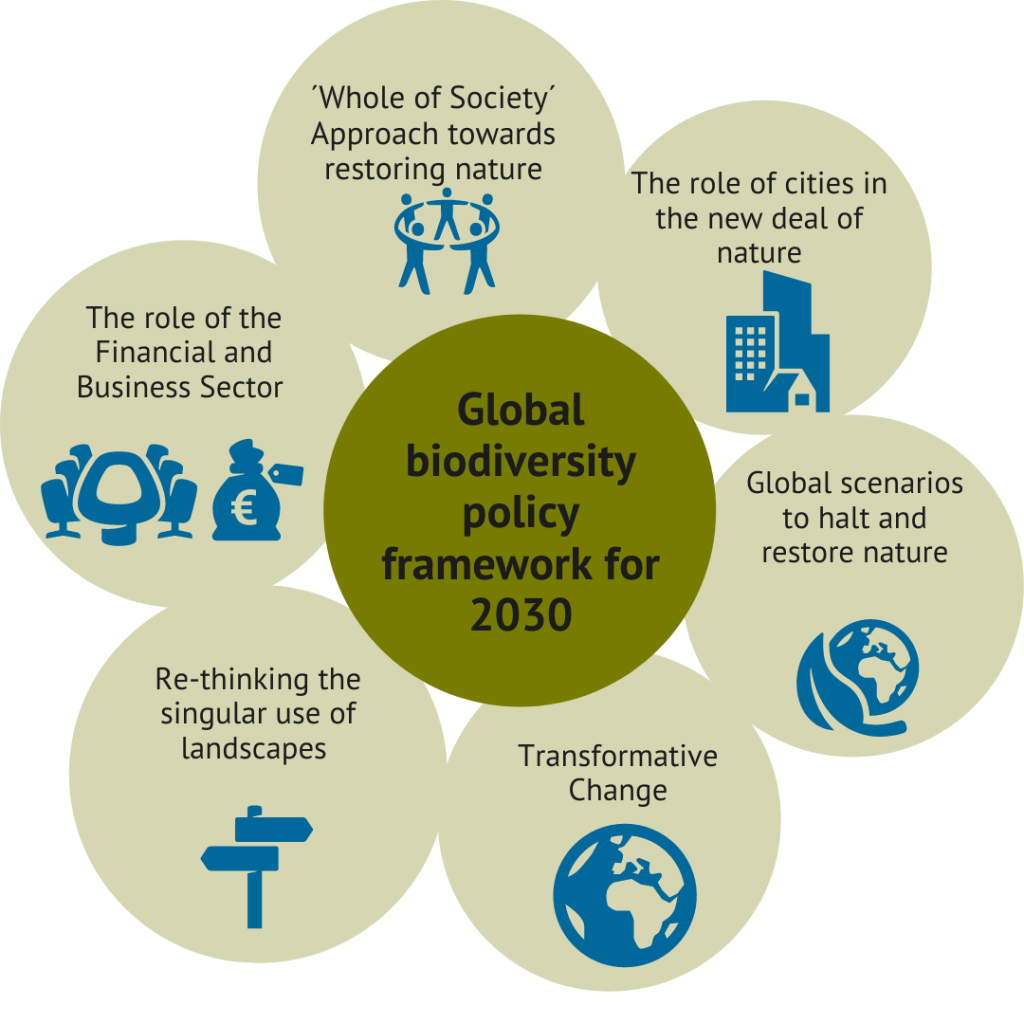
The challenge for the Conference organised by the Convention on Biological Diversity (CBD), in december 2022 in Montreal, is to agree on a global policy framework that stimulates urgent and transformative action by governments and society at large to halt and restore nature, as specifically IPBES is calling for. These negotiations fall under the UN Convention on Biological Diversity, one of the three Rio Conventions agreed upon at the famous World Summit on Sustainable Development, held in Rio de Janeiro in 1992. The three key goals of the Biodiversity Convention are the conservation of biodiversity, the sustainable use of biodiversity components, and the sharing of the benefits from genetic resources in a fair and equitable way. In 2020, the CBD Strategic Plan 2011–2020, including the 20 Aichi targets, ended. Analysis of the Dutch contribution to the realisation of the Aichi targets can be found here. Negotiations on the new, post-2020 framework already started in 2018, but were stalled because of the global COVID-19 pandemic. Parts of the negotiations were continued online and will restart with face-to-face preparatory sessions in March 2022 in Geneva. Final decisions are expected to be made at the 15th Conference of the Parties to the CBD (CBD COP 15), now scheduled to be held in Kunming, China, in the third quarter of 2022.
PBL Netherlands Environmental Assessment Agency has relevant knowledge and insights to inform the international negotiations within this new policy framework. These areas include, especially, future trends in the state of global biodiversity; scenarios on achieving biodiversity goals; the way in which various societal actors (e.g. from the business and finance sectors) and multi-stakeholder platforms in landscapes and cities can contribute to transformative change for biodiversity; and options that could contribute to a more effective international agreement on biodiversity. This page provides a concise overview of PBL research and key publications and international reports and articles to which we have contributed.
Global scenarios to halt biodiversity loss and restore nature
At PBL, we work with global scenarios. In other words, we analyse the consequences for biodiversity in alternative ´futures´ and present solution-oriented scenarios to achieve global goals. We have created two alternative conservation and agricultural scenarios: Half Earth and Sharing the Planet. These two scenarios represent our interpretation of current academic and societal debate on conservation and agriculture and offer two possible ways to achieve a positive future for nature. In other words, these scenarios present what could and would need to happen to halt biodiversity loss and restore nature. These scenarios show what would be necessary if we are to bend the curve for biodiversity. The conservation and agricultural options presented are part of a broader palette of options, such as improved agricultural productivity, dietary change and food waste reductions to realise the goals for conservation, climate change mitigation, and food security, simultaneously.
The Sharing the Planet scenario is aimed at integrating natural and human systems to form shared and multifunctional landscapes where nature is conserved for both its instrumental and relational values. Under the Half Earth scenario, nature is protected, and conservation is aimed at separating human pressures from nature. This means that agriculture will need to apply further intensification, in order to spare natural land, increase food production and reduce environmental externalities.
The restoration of degraded land plays an important role in both scenarios. The global potential of restoration has been elaborated in this scenario study for the Global Land Outlook of the UNCCD. This scenario includes measures on restoration and improved land management, as well as protection and conservation of key ecosystems. To highlight the importance of restoration and to strengthen worldwide related efforts, the UN has announced the UN Decade on Ecosystem Restoration (2021–2030).
Also, are you curious about how these scenarios compare where it comes to biodiversity, global temperatures and food prices? Click here to see a dynamic graph, which tells you more about nature-based solutions and restoration.
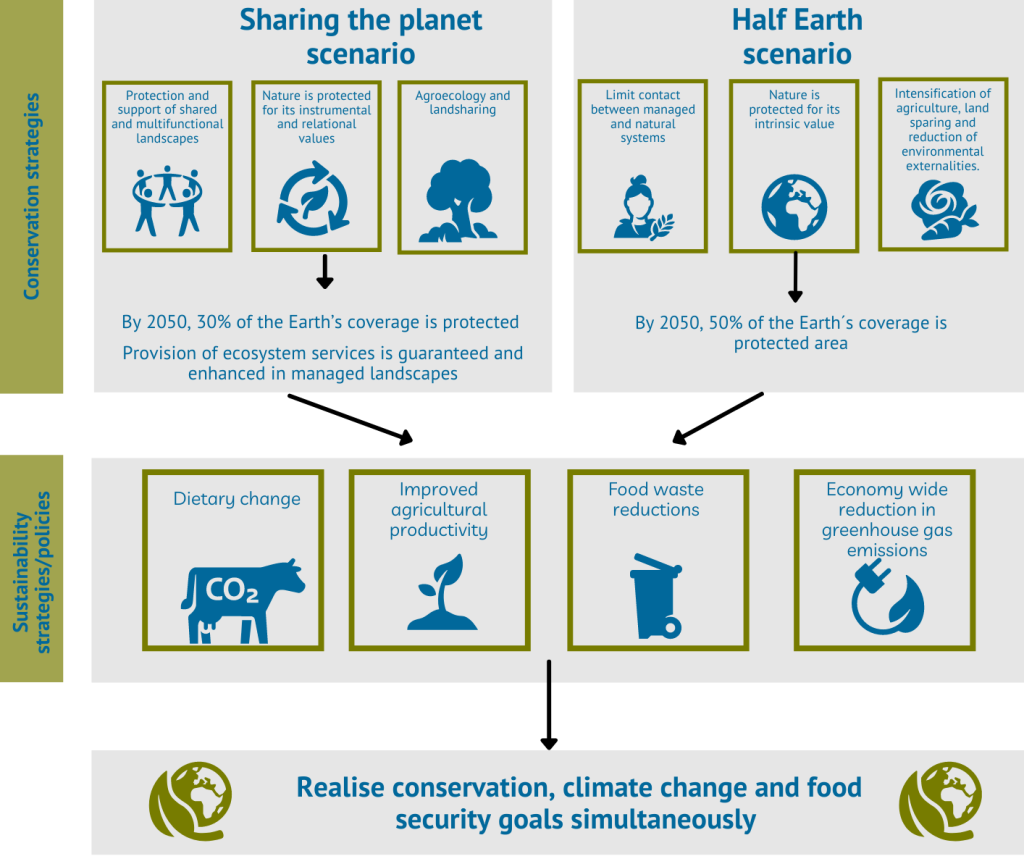
A ´whole of society´ approach towards restoring nature
The new global biodiversity framework emphasises the need for society as a whole to take action, if we are to bend the curve on biodiversity loss. The change will also have to come from the bottom-up. The Action Agenda for Nature and People of the CBD is a place where cities, regions, companies, indigenous peoples, local communities, the financial sector and other non-state actors can commit to taking actions that will halt and reverse biodiversity loss. The Action Agenda can become an important step towards the success of this approach. PBL has analysed how various non-state actors, including businesses, cities and stakeholder platforms in landscapes, can contribute to catalysing global biodiversity governance. For more information on the whole-of-society approach as well as on the opportunities of the Action Agenda for Nature and People. The next step for the CBD is to engage a larger group of stakeholders and ensure that their commitments for biodiversity will be credible, which requires an effective accountability and transparency mechanism for non-state actors.
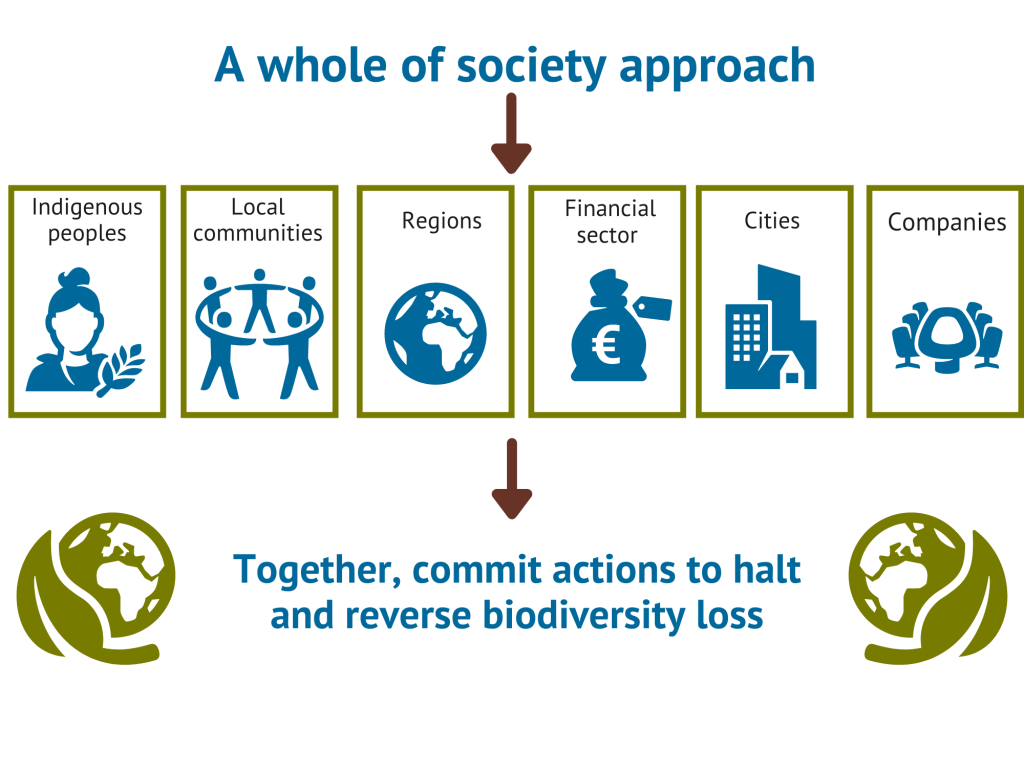
The role of cities in the new deal for nature
By converting nature habitats into cities, urbanisation is a major driver of environmental change. The global population largely lives in or near towns and cities (currently 55%) and urbanisation is expected to continue to expand, around the world. Therefore, how we live and the way we see cities and urban development will determine the nature and extent of biodiversity loss and recovery. By restoring, conserving and thriving with nature (e.g., by hosting a wealth of plants and animals), cities also have much to gain — from addressing climate change to improving the health and physical, mental and social well-being of their communities. Now could be a good time to seize the opportunity for embedding an urban perspective throughout the post-2020 Global Biodiversity Framework.
The role of the Financial and Business Sectors
By wisely and critically choosing what, where and how we consume and produce, we could contribute to halting biodiversity loss and promoting nature restoration. This requires the involvement of the business community and the financial sector. Loss of biodiversity leads to financial risks and threatens the availability of ecosystem services, such as wood, animal pollination and soil fertility, on which economic activities depend. As a result, banks, pension funds and insurers that provide the funds for these economic activities are facing physical risks. Financial institutions face transition risks or reputational damage when they finance companies that have a major negative impact on biodiversity.
Therefore, businesses and financial institutions are to integrate biodiversity into their business model, and targeted government policies are needed to mobilise more companies — including market leaders, followers, and laggards.
Rethinking the singular use of landscapes
Converting nature areas into agricultural land is a leading cause of biodiversity loss. With the increasing competition for space, and the realisation that nature is part of the solution when it comes to sustainably managing various interlinked societal challenges, there is a need for more integrated and inclusive management of land and water resources.
The conventional policy approaches in which land is believed to serve just one purpose at a time, such as either farming or forestry, and where this is a trade-off with other objectives, are no longer viable, in many parts of the world. One of the proposed solutions is that of combining supply-chain and landscape approaches to develop ‘nature-positive’ or ‘nature-inclusive’ development trajectories in agricultural production or working landscapes that involve economic sectors such as agriculture, forestry, fisheries and resource extraction.
Transformative change
Halting biodiversity loss and taking nature along a path towards recovery requires fundamentally transforming our economies, policies and mindsets. Decisions need to be made across all levels of society, business and government. While putting ´transformative change´ at the centre in the new global biodiversity framework, the question is what options are for harnessing its potential. If the new framework is to usher in a new era of transformative change for nature and people, it must do more than establish ambitious targets. It must also provide guidance and governance mechanisms for our collective journey towards achieving those ends. It requires creating a positive vision and narrative on the various possibilities while supporting a new shared understanding, and relationships and intentions about the need and scope for action, the multiple values involved, and how various approaches could be mobilised. This will require transforming global biodiversity governance itself.
Relevant PBL publications and news items
- Rapport | 18 November 2021Accountability of commitments by non-state actors in the CBD post-2020 Global Biodiversity Framework
- Rapport | 14 January 2021Realising the Urban Opportunity: Cities and the Post-2020 Biodiversity Governance
- Artikel | 16 May 2019Towards a Global Biodiversity Action Agenda
- Nieuws | 16 November 2021PBL Academy Lecture: Biodiversity from an integral perspective
- Rapport | 30 July 2021Seizing the landscape opportunity to catalyse transformative biodiversity governance
- Rapport | 15 June 2021Climate change measures and sustainable development goals
- Nieuws | 15 June 2021Climate mitigation measures have mainly positive effects on achieving Sustainable Development Goals
- Nieuws | 4 June 2021Land restoration can make a significant contribution to sustainable development at the global level
- Rapport | 30 June 2020Business for Biodiversity
- Publicatie | 27 June 2019Opportunities for the Action Agenda for Nature and People
- Rapport | 30 July 2021Seizing the landscape opportunity to catalyse transformative biodiversity governance
- Nieuws | 18 June 2020DNB and PBL: biodiversity loss is a source of financial risk
- Nieuws | 30 June 2020Companies badly needed for biodiversity targets
- Rapport | 14 January 2021Realising the Urban Opportunity: Cities and the Post-2020 Biodiversity Governance
- Rapport | 9 September 2020Narratives for the “Half Earth” and “Sharing The Planet” scenarios
- Artikel | 10 September 2020Bending the curve of terrestrial biodiversity
- Publicatie | 27 June 2019Opportunities for the Action Agenda for Nature and People
